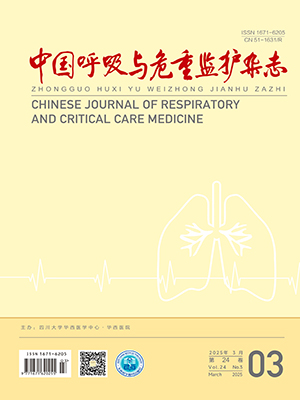Objective To investigate the serumlevel of endothelin-1 ( ET-1) in patients with acute lung injury/acute respiratory distress syndrome ( ALI/ARDS) and its clinical significance.
Methods Thirty-one ALI/ARDS patients received mechanical ventilation in ICUand 25 normal subjects were recruited in the study. The patients who died in two weeks fell in death group, and the patients who did not died in two weeks fell in survival group. The serum level of ET-1 measured by EIA method were compared between the
patients with different severity of lung injury [ evaluated by American-European Consensus Conference on ARDS ( AECC) criteria and lung injury score( LIS) ] , and between the patients with different prognosis ( death or survival ) . The correlation was analyzed between the level of ET-1 and clinical parameters.
Results The ET-1 level was higher in the ALI/ARDS patients than that in the control subjects [ ( 6. 18 ±4. 48) ng/L vs. ( 2. 68 ±1. 34) ng/L, P lt;0. 05] . There was no significant difference in the patients with different severity [ ALI vs. ARDS, ( 5. 43 ±4. 39) ng/L vs. ( 7. 01 ±4. 51) ng/L, P gt; 0. 05; LIS≤2. 5 vs.LIS gt;2. 5, ( 5. 93 ±5. 21) ng/L vs. ( 6. 68 ±2. 76) ng/L, P gt; 0. 05] . The ET-1 level in the death group continued to increase, and higher than that in the survival group on the 5th day [ ( 7. 96 ±3. 30) ng/L vs.( 4. 36 ±3. 29) ng/L, P lt; 0. 05] . The ET-1 level was positively correlated with SIRS, SAPSⅡ and APACHEⅡ ( r = 0. 359, 0. 369 and 0. 426, respectively, P lt; 0. 05 ) , and negatively correlated with PaO2 /FiO2 and AaDO2 ( r = - 0. 286 and - 0. 300, respectively, P lt;0. 05) .
Conclusion The measurementof serum ET-1 can help to evaluate the severity and prognosis of ALI/ARDS patients.
Citation: ZHANG Wenbin. Clinical Significance of Serum Endothelin-1 in Patients with Acute Lung Injury/Acute Respiratory Distress Syndrome. Chinese Journal of Respiratory and Critical Care Medicine, 2011, 10(5): 466-469. doi: Copy
Copyright © the editorial department of Chinese Journal of Respiratory and Critical Care Medicine of West China Medical Publisher. All rights reserved




